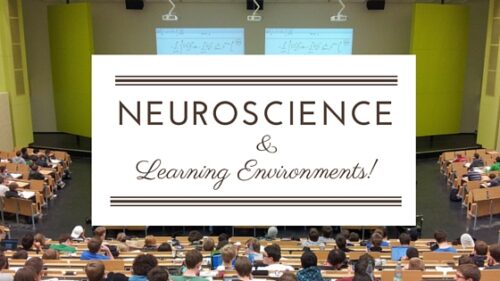Environmental Factors of Learning to Consider Before Designing Your Next Course
When you plan your live face-to-face training events, do you put much thought into it’s location? And when you finally decide on a location how much attention do you pay to the space? We’re all busy professionals and sometimes we feel lucky to even find an available room in our busy office spaces. We spend our valuable time on instructional design, content creation, and course administration. Because that is in our immediate control. The environment is often an afterthought and more out of our control. But in our constant drive to create better learning experiences, and in light of recent neuroscience findings, perhaps training locations should be as important to learning as stating learning objectives.
Learner Control vs. Designer Control
Sadly, the thoughtful design of a learning environment is no longer our responsibility. The continual growth of eLearning has shifted control of environment from the designer to the learner. When we design and deliver a completely online experience we willingly give up control of the physical learning space to our audience. We willingly accept that our designs will be as successful from a computer at home, or within an office cubical. Or on a laptop in bed, or lounging poolside. Because in many cases you simply don’t know where or when people are engaging in your learning content. And that is the beauty of online learning, right? Or is it?
I believe in technology as a powerful learning tool. But the more we move towards digital learning experiences, the more I realize the power of the analog experience. Human to human interactions, and the real world spaces and places where they occur. I don’t believe one is more powerful than the other. But I do believe that in some instances we’ve tossed out the baby with the bath water. It’s so easy to move content to a self-paced online format, and doing so no doubt saves money, time, and resources. But perhaps our industry should be having more conversations about real life, human to human, training formats…instead of less.
Neuroscience Changes Everything
Neuroscience is exposing more and more about how our brains work. I find it fascinating, and exciting, because most of the theories our industry follows are based on the softer behavioral sciences. We now have researchers in the hard sciences uncovering the wonders of our neuroanatomy. Some of these discoveries will confirm what we are doing, while others will require us to stop and rethink our approach. But in either case we see a combined better understanding of how the digital and analog worlds together will impact our brains.
You can learn a lot about the basic science of learning from Dr. Medina’s books and videos about Brain Rules. He has uncovered the strongest scientific evidence for how to improve the function of our brains. And yet, most of it goes unnoticed, or unimplemented, in our institutions of education. In this video Dr. Medina gets right to the point within the first minute exposing the “almost perfect ANTI-brain learning environment.”
As his videos tend to get me rethinking a lot of things in my life, this time around I was struck by his comments on “environment“. That got me thinking about other professions that deal with creating environments.
Neuroscience, Architecture, and Learning Environments
And that led me to the Academy of Neuroscience for Architecture. And it was an article in the Pacific Standard titled Could Neuroscientists be the next Great Architects? that took me there.
This article struck me with a few great lines…
“Today, the near 10-year-old Academy of Neuroscience for Architecture believes that neuroscience could make science’s greatest contribution to the field of architecture since physics informed fundamental structural methods, acoustic designs, and lighting calculations in the late 19th century.”
“When Gage introduced these findings to architects at the American Institute of Architects’ 2003 convention, he pronounced an idea that is still sinking in: “Changes in the environment change the brain, and therefore they change our behavior.””
“Neuroscientists are also gaining an increasingly better understanding of how our brains analyze, interpret, and reconstruct place and space.”
And my personal favorite…
“We are now really beginning to understand better how to measure the responses to the built environment,” says Eduardo Macagno, professor of biological sciences at the University of California, San Diego, “without relying on psychology, social science, observational behavior.”
Those studies, he explains, “don’t have the quantitative and objective experimental approach that we believe neuroscience brings to the interface with architecture.”
In all honesty, there are far too many great lines in this article. It’s a short, but fantastic, read.
Neuroscience Supports Human to Human Learning
I’ve given up on seeing any significant change occurring in our public school systems based on neuroscience any time soon. However, I do believe that as corporate training professionals we are in a unique position to lead the way in applying neuroscience to our training programs. Most training departments and Corporate Universities were built from academic models. Those models are steeped in bureaucracy and red tape. You, however, have the power to take control of your training environment and apply neuroscience in the controlled environment of your workforce.
No, I’m not recommending that you add jogging to the course agenda. It could be something as simple as choosing a different classroom location. I’m hoping that you begin to pay closer attention to the little things when designing, developing, and implementing your face-to-face training events. The environment you choose for your face-to-face events is becoming more and more important as those human to human interactions occur less often.
Have you ever tried holding a classroom event outside? Perhaps in a nearby park? Or maybe in a rented movie theater?
As we begin to approach Q4 2015, many of you will be looking forward and planning your training strategy for 2016. Will you be moving more, or less content online? This is a good time for you to reflect on your currently training programs and look at trying something new. Something based on neuroscience.






